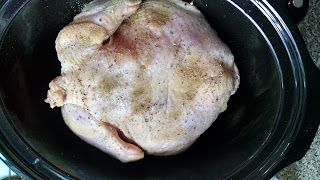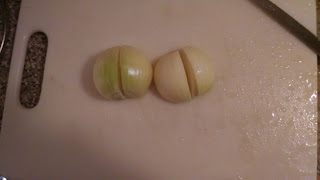If you're generally cooking for only one or two, a smaller crockpot is probably your best bet. Making a small recipe in a large crockpot often results in cooking too fast and burning sauces at the top edge. Luckily, most crockpot recipes can be cut down without too much difficulty. But if you often cook for a larger family or for company, or if you have a freezer in which to save the leftovers, a larger crockpot is for you.
This roast chicken recipe can be used with either a small or a large crockpot, simply by varying the size of the chicken you use. I love using the largest bird I can, because it allows for a full meal for my family of four plus enough leftovers for a second (and often a third) meal, and of course plenty of homemade broth from the carcass! A 3-4 pound bird is fine for a small crockpot; up to an 8-pounder will fit in a larger one.
Let's get started! First of all, peel the plastic from the bird and remove the giblets and neck. If you choose to rinse the chicken, pat it dry with paper towels.
Place the chicken into the crock, breast-side down. With some crockpot recipes, I like to spray the crock with cooking spray or use a crockpot liner, but roast chicken creates enough of its own juices to avoid sticking, and it's easier to make the stock afterwards without a liner, so for this recipe I don't bother.
Sprinkle the bird generously with salt, pepper, and whatever seasonings you prefer. I like to use poultry seasoning, but an Italian seasoning blend also works nicely, or just toss in whatever herbs you like and have on hand.
Very soon you'll start to smell a wonderful aroma, and if you take a peek, the lid will have some condensation on it, and you'll notice that there is a fair amount of liquid in the crock.
This particular chicken was about 7-1/2 pounds, and the thingie popped at about 5-1/2 hours. If I was planning to shred the chicken, I'd have let it go another half hour or so, but since we were eating it as is, I wanted to keep the meat a bit firmer.
The skin doesn't crisp up in the crockpot (if you like crispy skin, you can always toss it under the broiler for a few minutes to crisp it up), so simply peel it off and cut off large pieces of breast to serve - you can leave it right in the crock to carve it, if you like.
I served mine with herbed oven roasted potatoes (cut 2 pounds of potatoes - skin on but well scrubbed - into 1" chunks and toss them with 1 tsp each of garlic powder, black pepper, parsley, and rosemary, a little salt, and 2 Tbsp of olive oil, then lay them on a cookie sheet lined with parchment paper and bake at 425 for 30 minutes or so) and peas. So yummy!
After dinner, finish pulling the meat off the carcass (for this step, I do pull it out of the crock and use a cutting board; it's easier to get at all the small bits of meat) and toss it in the fridge for later, then return everything else to the crock, including the skin. Don't dump out the liquid from the cooking! If you're planning to make soup right away, don't worry about getting every last bit of meat off - you can retrieve it when you strain it and put it right back into the soup. If you're not squeamish, break any of the smaller bones that you can. That will release the marrow and give the broth a richer flavor.
Here is where it gets creative. I like to use onion, celery, carrots, garlic, poultry seasoning, and salt and pepper in my stock. But use whatever you like and/or have on hand. No celery? Leave it out or toss in some celery salt. Don't have an onion? Throw in a bit of onion powder or onion salt. Ditto for replacing fresh or minced garlic with powder or salt. (If you use salt for any of these, omit or greatly reduce the added salt.)
I prefer to peel my onions and carrots, although some people don't bother. Just cut everything into big chunks and toss them in the pot.
I gauge my amounts by what I have on hand. if I have a huge bag of carrots that I know I'll never use up before they go bad, I'll toss in 4 or 5 of them. If I only have two sad stalks of wilted celery, I'll use it up. If I'm running low on onions, I'll only use half of one or toss in a handful of frozen chopped.
Once you've added all the vegetables, fill the crock with water until it's about an inch lower than the level of the lid. (It's an interesting lesson on flotation: onions and celery float; carrots sink.)
Add the garlic, herbs, salt and pepper, and any other incidentals you like (some people like to add a pinch of red pepper flakes!) and give the whole shebang a quick stir.
Since I usually do this process right after supper, I set my crockpot on high for a few hours until I go to bed, then I turn it down to low and leave it overnight. If you're doing it late at night, leave it on low all night and it'll be just fine. If you'd rather finish up in less than 8-12 hours, leave it on high for 4 or 5. It's not picky. (See? This is why I love crockpots. They're very forgiving.)
In the morning, turn off the crock, remove the lid, and allow the broth to cool for a bit, then set a metal sieve (or a plastic colander) over a leftover container and use a large ladle to scoop up the contents of the crock and pour them in. If your containers are an inconvenient size or shape for straining, strain the broth into a large glass measuring cup with a spout and pour it into the containers from there. I put two plastic grocery bags together in the sink and periodically dump out the contents of the sieve. If you're planning on making soup, sift through the remains in the colander and save any decent-sized bits of meat to add to the soup.
Let the broth cool a bit more before storing in the refrigerator or freezing for later use. Once the broth has chilled, you can go back and skim off the fat that's congealed at the top, or you can just wait until you use that particular container and skim it then. Homemade stock is much thicker than storebought, so don't worry if your stock is the texture of melty jello! It will liquefy as it reaches room temperature. You may also notice a dark sludge in the bottom of the containers - this is the herbs and seasonings! Use it if you want a stronger herb flavor to your broth, or leave it behind if you prefer a milder flavor or a clearer look.
You can also make broth from the carcass of a storebought rotisserie chicken or a chicken you roasted in the oven. If you don't have time to make stock right away and you have room in the freezer, wrap the carcass in plastic wrap and freeze it until it's convenient. You can even save celery, onions, and carrots in the freezer to use in your broth - freezing ruins the texture but not the flavor, and since you're throwing away the vegetables, the texture doesn't matter in the least.
I find the flavor of homemade broth is much richer and tastier than the stuff from a box or a can. If you have a large crockpot, you'll end up with quite a bit of broth, so you may want to experiment with replacing part of the water when you cook rice or make instant mashed potatoes, use it instead of milk when you make real mashed potatoes, use it for risotto and soup and anything else you can think of!
Enjoy!





















No comments:
Post a Comment